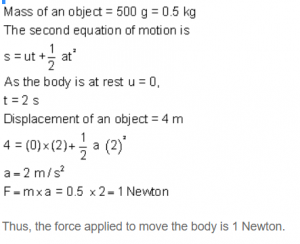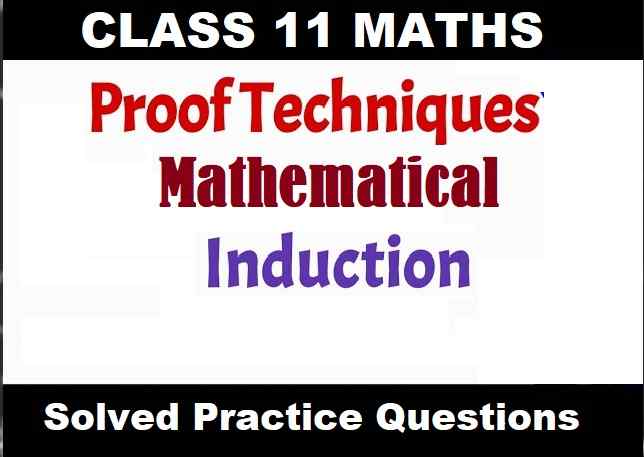Laws of Motion Exe-3C Linear Momentum Newton’s Second Law Numericals Answer Type for Class-9 ICSE Concise Physics. There is the solutions of Numericals Answer type Questions of your latest textbook which is applicable in 2023-24 academic session. Visit official Website CISCE for detail information about ICSE Board Class-9.
Laws of Motion Exe-3C Linear Momentum Newton’s Second Law Numericals Answer
(ICSE Class – 9 Physics Concise Selina Publishers)
| Board | ICSE |
| Class | 9th |
| Subject | Physics |
| Writer / Publication | Concise selina Publishers |
| Chapter-3 | Laws of Motion |
| Exe – 3C | Linear Momentum Newton’s Second Law |
| Topics | Solution of Exe-3(C) Numericals Answer Type |
| Academic Session | 2023-2024 |
Exe-3C Linear Momentum Newton’s Second Law Numericals Answer Type
Ch-3 Laws of Motion Physics Class-9 ICSE Concise
Page 77
Question 1. A body of mass 5 kg is moving with velocity 2 m s-1. Calculate its linear momentum.
Answer:
Mass of the body, m = 5kg
Velocity, v = 2 m/s
Linear momentum = mv = (5)(2) kg m/s
= 10 kg m/s-1
Question 2. The linear momentum of a ball of mass 50 g is 0.5 kg m s-1. Find its velocity.
Answer:
Linear momentum = 0.5 kg m/s
Mass, m = 50 g = 0.05 kg
Velocity = Linear momentum/mass
= 0.5/0.05 m/s
= 10 m/s -1
Question 3. A force of 15 N acts on a body of mass 2 kg. Calculate the acceleration produced.
Answer:
Force, F = 15 N
Mass, m = 2kg
Acceleration, a = F/m [ From Newton’s second law]
Or, a = (15/2) ms-2
Or, a = 7.5 ms-2
Question 4. A force of 10 N acts on a body of mass 5 kg. Find the acceleration produced.
Answer:
Force, F = 10 N
Mass, m = 5kg
Acceleration, a = F/m [ From Newton’s second law]
Or, a = (10/5) ms-2
Or, a = 2 ms-2
Question 5. Calculate the magnitude of force which when applied on a body of mass 0.5 kg produces an acceleration of 5 m s-2.
Answer:
Mass, m = 0.5 kg.
Acceleration, a = 5 ms-2
Force, F = ma [ From Newton’s second law]
Or, F = (0.5) (5) N = 2.5 N.
Question 6. A force of 10 N acts on a body of mass 2 kg for 3 s, initially at rest. Calculate: (i) The velocity acquired by the body and (ii) Change in momentum of the body.
Answer:
Force, F = 10 N
Mass, m = 2 kg
Time, t = 3 s
Initial velocity, u = 0 m/s.
(i) Let v be the final velocity acquired.
From Newton’s second law,
F = ma.
Or, a = F/m = 10/2 = 5 ms-2.
From the 1st equation of motion,
a = (vu)/t
Or, v = at + u.
Or, v = (5)(3) + 0 = 15 m/s-1
(ii) Change in momentum = Final momentum initial momentum
p = mv mu.
Or, p = m (vu).
Or, p = 2 ( 15 0) = 30 kg m/s-1
(Laws of Motion Exe-3C Numericals Class-9 ICSE)
Question 7. A force acts for 10 s on a stationary body of mass 100 kg, after which the force ceases to act. The body moves through a distance of 100 m in the next 5 s. Calculate: (i) The velocity acquired by the body, (ii) The acceleration produced by the force and (iii) The magnitude of the force.
Answer:
Mass, m = 100 kg
Distance moved, s = 100 m
Initial velocity, u = 0
(i) Because the body moves through a distance of 100 m in 5 s,
Velocity of the body = Distance moved / time taken
Velocity = (100/5) = 20 m/s-1
(ii) From Newton’s third equation of motion,
v2 u2 = 2as.
Or, a = (v2 u2) /2s.
and, a = [ (202 02)/ 2(100) ] ms-2.
hence, a = 2 ms-2.
(iii) Force, F = ma
Or, F = (100) (2) N.
therefore, F = 200 N.
Question 8. Fig 3.11. shows the velocity-time graph of a particle of mass 100 g moving in a straight line. Calculate the force acting on the particle.
(Hint : Acceleration = Slope of the v–t graph)

Answer:
Slope of a velocity-time graph gives the value of acceleration.
Here, slope = 20/5 = 4 m/s2.
Or, acceleration, a = 4 m/s2.
Force = Mass × Acceleration.
Given mass, m = 100 g = 0.1 kg.
Force = (0.1) (4) = 0.4 N.
Laws of Motion Exe-3C Numericals Class-9 ICSE
Ch-3 Laws of Motion Physics Class-9 ICSE Concise
Page 78
Question 9. A force causes an acceleration of 10 m s-2 in a body of mass 500 g. What acceleration will be caused by the same force in a body of mass 5 kg?
Answer:
Let the force be F.
Force F causes an acceleration, a = 10 m/s2 in a body of mass, m = 500 g or 0.5 kg
Thus, F = ma
Or, F = (0.5) (10) = 5 N
Let a’ be the acceleration which force F (=5N) cause on a body of mass, m’ = 5 kg.
Then, a’ = F/m’.
Or, a’ = (5/5) ms-2.
Or, a’ = 1 ms-2.
Question 10. A cricket ball of mass 150 g moving at a speed of 5 ms-1 is brought to rest by a player in 0.003 s. Find the average force applied by the player.
Answer:
Question 11. A force acts for 0.1 s on a body of mass 2.0 kg initially at rest. The force is then withdrawn and the body moves with a velocity of 2 m s-1. Find the magnitude of the force.
Answer:
Mass, m = 2 kg
Initial velocity, u = 0
Final velocity, v = 2 m/s
Time, t = 0.1 s
Acceleration = Change in velocity/time
Or, a = (v u) /t
Or, a = (2 0)/ 0.1 = 20 ms-2.
Force = Mass Acceleration
Or, F = (2) (20) = 40 N.
Question 12. A body of mass 500 g, initially at rest, is acted upon by a force which causes it to move a distance of 4 m in 2 s, Calculate the force applied.
Answer:

Question 13. A car of mass 480 kg moving at a speed of 54 km per hour is stopped in 10 s. Calculate the force applied by the brakes.
Answer:
Mass, m = 480 kg.
Initial velocity, u = 54 km/hr = 15 m/s.
Final velocity, v = 0.
Time, t = 10 s.
Acceleration = Change in velocity/time.
Or, a = (v u)/t.
Or, a = (015)/10 = -1.5 ms-2.
Here, negative sign indicates retardation.
Now, Force = Mass Acceleration
Or, F = (480) (1.5) = 720 N.
Question 14. A car is moving with a uniform velocity 30 ms-1. It is stopped in 2 s by applying a force of 1500 N through its brakes.
Calculate the following values:
(a) The change in momentum of car.
(b) The retardation produced in car.
(c) The mass of car.
Answer:
Initial velocity, u = 30 m/s
Final velocity, v = 0
Time, t = 2s
Force, F = 1500 N
Here, a = (v u)/t = (0 30)/ 2 = 15 ms-2. Here, negative sign indicates retardation.
Now, F = ma.
Or, m = F/a = (1500/ 15) = 100 kg.
(a) Change in momentum = Final momentum – Initial momentum
Or, p = m (vu)
and , p = 100 (0 30)
Hence, p = 3000 kg m/s-1
(b) Acceleration, a = (vu)/t.
Or, a = (0 30)/ 2 = 15 ms-2,
Here, negative sign indicates retardation.
Thus, retardation = 15 ms-2.
(c) From Newton’s second law of motion,
F = ma
Or, m = F/a = (1500/ 15) = 100 kg.
Question 15. A bullet of mass 50 g moving with an initial velocity 100 m s-1 strikes a wooden block and comes to rest after penetrating a distance 2 cm in it.
Calculate:
(i) Initial momentum of the bullet,
(ii) Final momentum of the bullet,
(iii) Retardation caused by the wooden block and
(iv) Resistive force exerted by the wooden block.
Answer:
Mass, m = 50 gm = 0.05 kg.
Initial velocity, u = 100 m/s.
Final velocity, v = 0.
Distance, s = 2cm = 0.02 m.
(i) Initial momentum = mu = (0.05) (100) = 5 kg m/s-1
(ii) Final momentum = mv = (0.05) (0) = 0 kg m/s.
(iii) Acceleration, a = (v2 u2)/2s.
Or, a = (02 1002)/ 2(0.02).
Or, a = 2.5 105 ms-2.
Therefore, retardation is 2.5 105 ms-2.
(iv) Force, F = ma
Or, F = (0.05 kg) (2.5 105 ms-2)
Or, F = 12500 N
— : End of Laws of Motion Exe-3C Linear Momentum Newton’s Second Law Numericals Answer Type Solutions :–
Return to Concise Selina Physics ICSE Class-9 Solutions
Thanks
Please share with your friends


